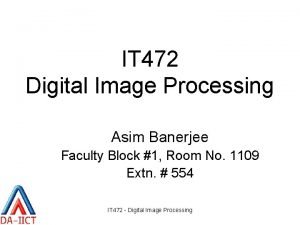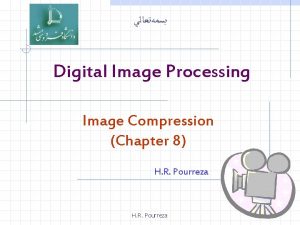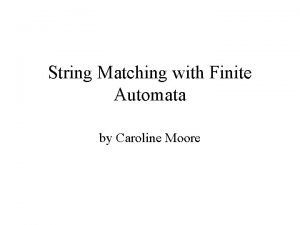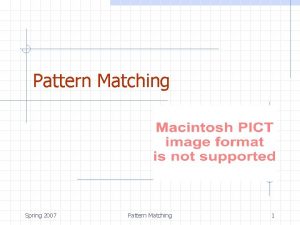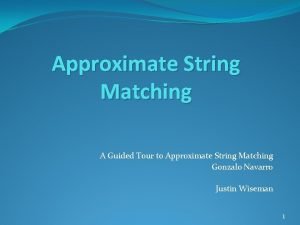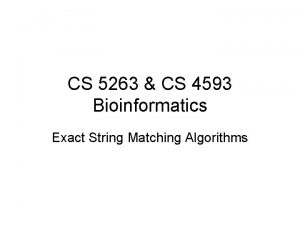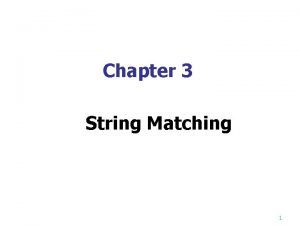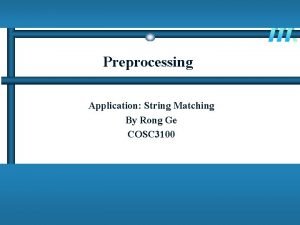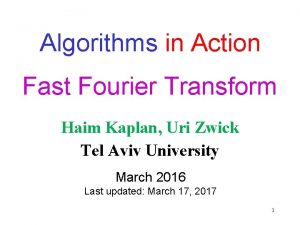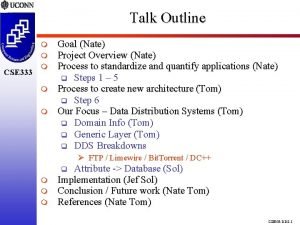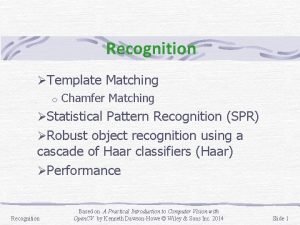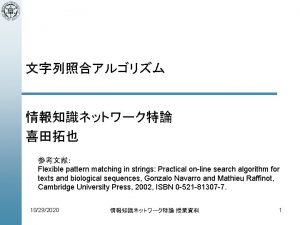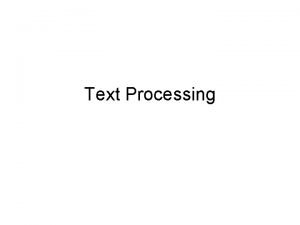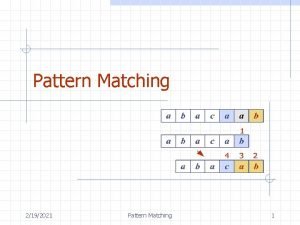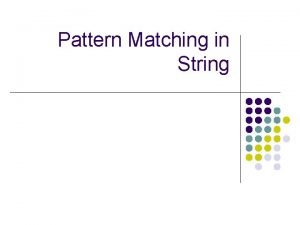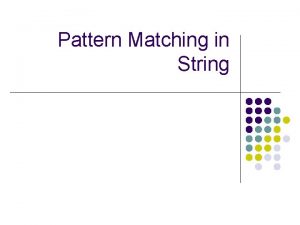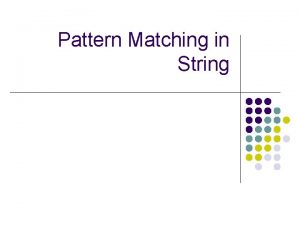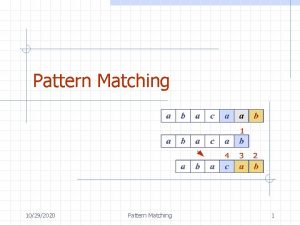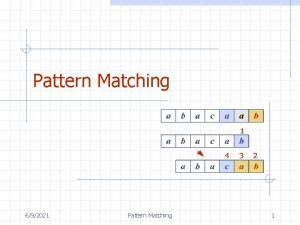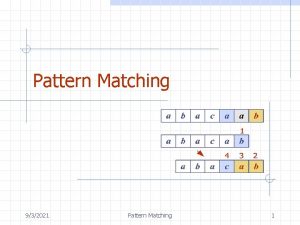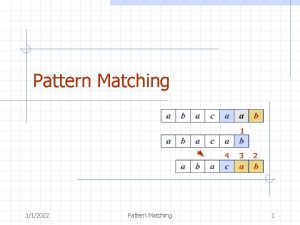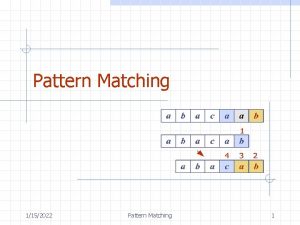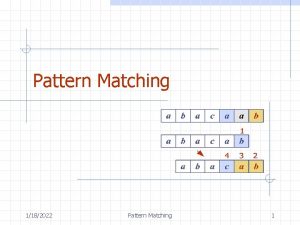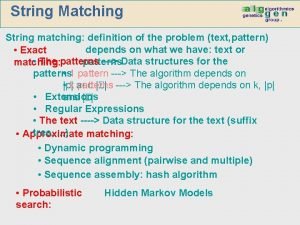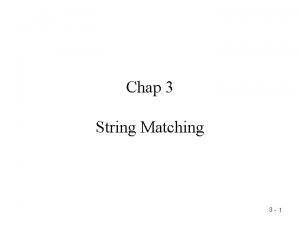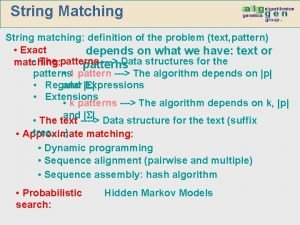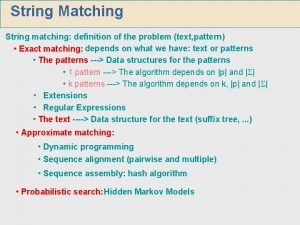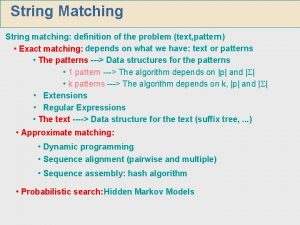Outline String String Processing Pattern Matching EncryptionDecryption Compression











![ตวอยางโปรแกรม #include<stdio. h> char x [30]; void main ( ) { printf (“Enter your ตวอยางโปรแกรม #include<stdio. h> char x [30]; void main ( ) { printf (“Enter your](https://slidetodoc.com/presentation_image_h/23f560a7f83afede7e532c01ea19a201/image-12.jpg)
![การกำหนดคาใหกบตวแปรเกบขอ ความ Example #include<stdio. h> void main ( ) { char mass[11] = “C การกำหนดคาใหกบตวแปรเกบขอ ความ Example #include<stdio. h> void main ( ) { char mass[11] = “C](https://slidetodoc.com/presentation_image_h/23f560a7f83afede7e532c01ea19a201/image-13.jpg)







![Pattern Matching Algorithms Input: An array T[n] of n characters representing a text and Pattern Matching Algorithms Input: An array T[n] of n characters representing a text and](https://slidetodoc.com/presentation_image_h/23f560a7f83afede7e532c01ea19a201/image-21.jpg)
















- Slides: 37


Outline �ทบทวน String ����������� (String Processing) �Pattern Matching �Encryption/Decryption �Compression









![ตวอยางโปรแกรม includestdio h char x 30 void main printf Enter your ตวอยางโปรแกรม #include<stdio. h> char x [30]; void main ( ) { printf (“Enter your](https://slidetodoc.com/presentation_image_h/23f560a7f83afede7e532c01ea19a201/image-12.jpg)
ตวอยางโปรแกรม #include<stdio. h> char x [30]; void main ( ) { printf (“Enter your name : ”); ผลลพธ Enter your name : manee dee Your name : manee dee gets(x); printf (“Your name : %sn”, x); }
![การกำหนดคาใหกบตวแปรเกบขอ ความ Example includestdio h void main char mass11 C การกำหนดคาใหกบตวแปรเกบขอ ความ Example #include<stdio. h> void main ( ) { char mass[11] = “C](https://slidetodoc.com/presentation_image_h/23f560a7f83afede7e532c01ea19a201/image-13.jpg)
การกำหนดคาใหกบตวแปรเกบขอ ความ Example #include<stdio. h> void main ( ) { char mass[11] = “C Language”; char book[4] = {‘A’, ‘B’, ‘C’, ‘�’}; } printf (“%sn”, mass); printf (“%sn”, book); printf (“%cn”, mass[3]); ผลการรน C Language ABC a



ตวอยางโปรแกรมการใชฟงกชนของ string #include<stdio. h> #include<string. h> if (res>0) { strcpy(temp, name 1); strcpy(name 1, name 2); strcpy(name 2, temp); int main() { char name 1[10], name 2[10], temp[10]; int res; printf("enter 2 string : "); scanf("%s %s", name 1, name 2); } printf("%s %sn", name 1, name 2); else if (res<0) printf("lessn"); else // res == 0 { // cannot use like this //name 1 = "dararat"; res = strcmp(name 1, name 2); printf("greatern"); } printf("same and length = "); printf("%dn", strlen(name 1)(; } return 0;

Don’t Sleep Yet…

String Processing �Pattern Matching �Encryption/Decryption �Compression

Pattern Matching �given a string of n characters called text (T) , and a string of m (m<=n) characters called pattern (P) �find a substring of the text that match the pattern

Pattern Matching Algorithms �Brute-Force �Boyer-Moore �Knuth-Morris-Pratt
![Pattern Matching Algorithms Input An array Tn of n characters representing a text and Pattern Matching Algorithms Input: An array T[n] of n characters representing a text and](https://slidetodoc.com/presentation_image_h/23f560a7f83afede7e532c01ea19a201/image-21.jpg)
Pattern Matching Algorithms Input: An array T[n] of n characters representing a text and an array P[m] of m character representing a patterm Output: The index of the first character in the text that starts a matching substring or 1 if the search is unsuccessful

Brute-Force algorithm Algorithm for i to n-m do j 0 while j< m and P[j] = T[i+j] do j j+1 if j = m return i return -1

Brute-Force algorithm Example 1 T = “abacaabaccababb” P = “abacab” abacaabaccabacab abacaabacc abacab Result = “match” abacab …. abacab 27 comparisons

Brute-Force algorithm Example 2 T = “a pattern matching algorithm” P = “algor” apattern matching algorithm algor algor … Result = “match” algor ? comparisons

Boyer-Moore algorithm Algorithm �create a lookup table from P �เชน T = “abacaabad “abacaaba cababb” P = “abacab” cha a b c d Last(cha) 4 5 3 -1 ***Last(cha) = last position of the character in P

Boyer-Moore algorithm Algorithm (��� ) �compare from right to left 1 -by-1 �if not equal at position i in T, � if Ti is in lookup table �n = |last(Ti)-last(Pi)| �shift comparison to the next n location of T � if Ti is not in lookup table �shift comparison to the next m (ex. m=6) location of T

Boyer-Moore algorithm Example 1 T = “abacaabad “abacaaba cababb” P = “abacab” (m = 6) -------------------------------------abacaabad abacaaba cababb cha a b c d abacab abaca Last(cha) 4 5 3 -1 abacab abaca 13 comparisons abacab

Boyer-Moore algorithm Example 2 T = “a pattern matching algorithm” P = “algor” (m = 5) ---------------------------------a pat pa tern match matc ing algorithm algor algo algor cha a l g o r Last(cha) 0 1 2 3 4 ? comparisons

Boyer-Moore algorithm แบบฝกหด T = “a pattern matching algorithm” P = “rithm” (m = 5) ------------------------------------cha Last(cha)

Encryption/Decryption � Cryptographic computations encryption/decryption , digital signatures � To support secure communication over the Internet – using cryptographic computations for information security services

Encryption/Decryption � Before sending text, the original text – called plaintext , is encrypted into an unrecognizable string – called ciphertext � After receiving the ciphertext, it is decrypted back to the plaintext Plaintext encryption decryption Ciphertext

Encryption/Decryption � Basic techniques : Substitution , Transposition , Bit manipulation � the essential thing for each method is the secret key � Well-known Algorithms �DES (Data Encryption Standard) �RSA (Rivest-Skamir-Adleman) �Knapsack

Encryption/Decryption Example � Substitution (n = 4) � Transposition (3 x 6) � Bit manipulation (b = 3)

Compression � given a string X (ascii, unicode), encode into a small binary string Y � Huffman coding algorithm – based on character frequency to construct a binary tree , uses greedy method

Compression Eample “a fast runner need never be afraid of the dark” �frequency of each character char. a b d e f h i k n o r s t u v freq. 9 5 1 3 7 3 1 1 1 4 1 5 1 2 1 1

a = ‘ 010’ r = ‘ 011’ e = ‘ 100’ d = ‘ 1010’ Compression Eample (��� ) �Huffman tree 0 46 0 1 27 19 12 10 9 0 a e r 5 1 5 0 d 15 1 0 1 7 5 1 0 1 3 1 … …

การบาน �Knuth-Morris-Pratt algorithm
 Http protocol description
Http protocol description Pattern and pattern classes in image processing
Pattern and pattern classes in image processing Image compression model in digital image processing
Image compression model in digital image processing Spatial and temporal redundancy in digital image processing
Spatial and temporal redundancy in digital image processing 472
472 Jpeg in digital image processing
Jpeg in digital image processing String matching finite automata
String matching finite automata Algorithm for string matching
Algorithm for string matching A guided tour to approximate string matching
A guided tour to approximate string matching String matching
String matching String matching
String matching String matching in data integration
String matching in data integration String matching
String matching Input enhancement in string matching
Input enhancement in string matching Fft string matching
Fft string matching Cse 333
Cse 333 A guided tour to approximate string matching
A guided tour to approximate string matching Chamfer matching
Chamfer matching Image search reverse
Image search reverse What is apatri
What is apatri Graph pattern matching algorithm
Graph pattern matching algorithm Brute force pattern matching
Brute force pattern matching Pattern matching
Pattern matching Longest common subsequence applications
Longest common subsequence applications Char char slide
Char char slide Public class plant private string name
Public class plant private string name New string java
New string java Sandwich
Sandwich Top down processing
Top down processing Bottom up processing vs top down processing
Bottom up processing vs top down processing Bottom up and top down processing
Bottom up and top down processing Unsharp masking matlab
Unsharp masking matlab Primary and secondary food processing
Primary and secondary food processing Fractal image
Fractal image Histogram processing in digital image processing
Histogram processing in digital image processing Parallel processing vs concurrent processing
Parallel processing vs concurrent processing Neighborhood processing in digital image processing
Neighborhood processing in digital image processing Point processing
Point processing




